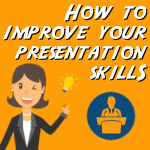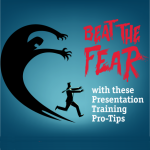(In conversation with Karen from our learning solutions delivery team)
Karen, we were talking about the welcome growing levels of face to face training we are experiencing (something we here at STL have maintained and supported throughout the last 2 years). We got onto considering that there are going to be a good number of us who may have to give our first in-person presentation for quite some time and it’s only natural to feel some nerves!
What suggestions would you recommend to someone preparing for a presentation?
Tip 1: Preparation is vital for great presentations
It’s important to remember that there is more to a successful presentation than simply standing in front of an audience and doing your thing. Preparation is vital and the more time and effort your commit to this, the better your chances of being successful.
Tip 2: Consider what you want the presentation to achieve.
As a result of your presentation do you want the audience to:
-
-
- Know something
- Decide something
- Do something
-
It could be just one of the above, a combination of or all three but it’s important to recognise exactly what you want from your audience before you begin to prepare.
If it’s a business presentation you should also consider if, by delivering it, will you be helping to improve:
-
-
- Productivity
- Efficiency
- Profitability
-
If the presentation doesn’t help increase any of these things, then ask yourself whether it’s worth doing at all? If it does, then make sure the audience knows that as well.
Tip 3: Do your audience research.
The more you know about who your audience are, the easier it becomes to tailor your presentation to ensure it meets their needs. Ask these questions to build a profile of your audience prior to delivering your presentation.
-
-
- What are their roles?
- How will your presentation benefit them?
- What relevant knowledge/experience do they already have?
- Is there anything in your presentation that might cause concern?
- What are their communication preferences?
-
Tip 4: Make sure your presentation has a clear beginning, middle and end.
Use the beginning of your presentation to explain the purpose and context. You might want to pose a question, make a statement or use some statistics and/or a picture that ‘hooks’ the audience and makes them eager to hear more.
The middle of your presentation is all about making sure you provide the right level of detail, delivered in the right way, that makes certain your audience have understood what you want from them as a result of your delivery.
We use the end of the presentation to confirm the important points you have made, to remind the audience of what you now want them to know, decide or do.
Tip 5: Check your logistics
Don’t make the mistake of preparing a beautiful presentation on PowerPoint and then finding that there is no projector available in the room. It’s also important to confirm how many people are likely to turn up as so you have enough space and refreshments. These, and many more, are mistakes I’ve made which meant I learned the hard way. A quick checklist of things to make sure meet your needs:
-
-
- Venue/Room
- Audience invites
- Technology
- Flip charts/pens
- Refreshments
-
Tip 6: Prepare yourself.
You know yourself better than anyone so make sure you prepare yourself to be successful.
-
-
- Practice the presentation beforehand and get some feedback.
- Get a good night’s sleep beforehand.
- Make sure you have water available as even the most confident of presenters can get a dry mouth.
- Visualise a successful presentation. This really works, try it!
-
Conclusion
As you see, your great presentation starts with great preparation. As Alexander Graham Bell wisely said “Before anything else, preparation is the key to success”
Thank you Karen for sharing these tips!
For some more tips check out further blogs and infographics:


